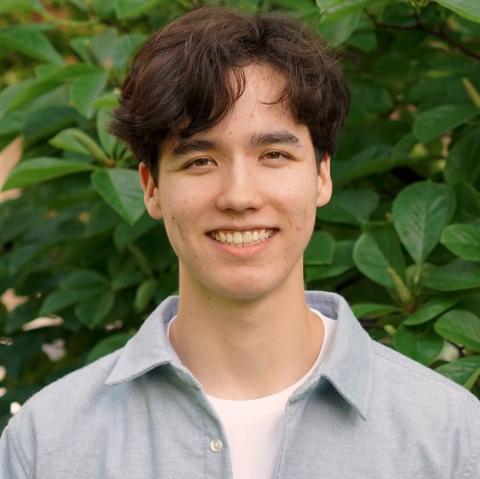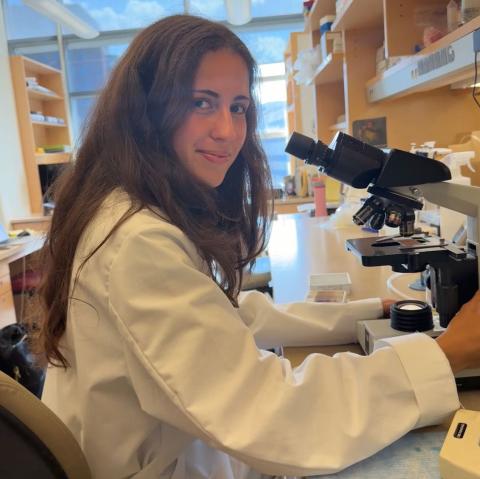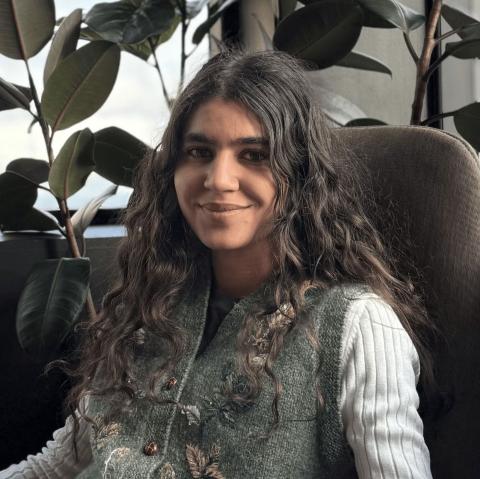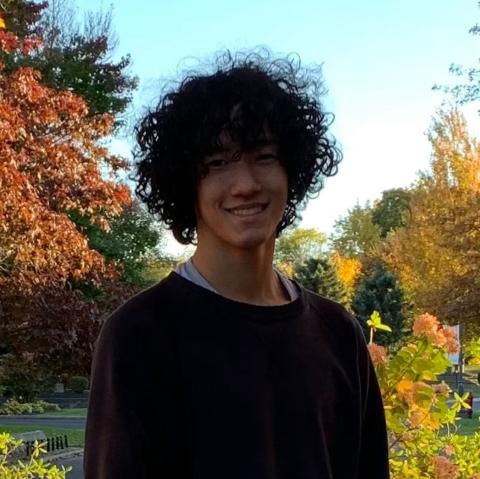Six students discuss their research ahead of Summer Intersections July 31
Across disciplines, Case Western Reserve University undergraduate students have spent their summer engaged in meaningful research and creative endeavors. From nutrition to dental medicine to computer science, they have gained valuable skills and insights.
They will share their findings with the campus community tomorrow (July 31) during the Summer Intersections symposium. Held three times a year, Intersections gives students experience presenting and communicating about their research and creative endeavors.
Members of the CWRU and broader communities are invited to see their work tomorrow (July 31) from 10 a.m. to noon in the Tinkham Veale University Center.
We spoke with a few student researchers to get a preview of some of the work that will be on display. Read about their projects and view the full presenter list.
Kian Burt

Second-year student majoring in nutrition working with faculty mentor Suchitra Nelson
1. Tell us about the project you’ll be presenting.
This project is investigating parent dental anxiety and its association with caries (cavities) in children. Previous literature suggests that dental anxiety in parents may raise the risk of cavities in their children. To test this relationship, this project analyzes cross-sectional data from a previously completed randomized clinical trial in Northeast Ohio.
2. What did you enjoy most about working on this project? What kind of work went into it?
I equally enjoyed the literature review process and analyzing data in RStudio. My appreciation for research grew as I observed how hypotheses developed across papers published from the 1980s to the present. I am also grateful to work with and receive continuous support from my principal investigator Dr. Suchitra Nelson and mentor David Selvaraj.
3. Why do you believe students should get involved with Intersections?
It’s rewarding to share research I’m passionate about, and very exciting to walk around and hear others present their own work. I’ve enjoyed walking around at previous Intersection events and am excited to be a presenter at one.
Catherina Iltchev

Third-year student majoring in economics working with faculty mentor Timothy Mead
1. Tell us about the project you’ll be presenting.
Sepsis and septic shock are life-threatening conditions that contribute to over 11 million deaths worldwide, and often involve long-term cardiovascular complications. My project focuses on a sepsis-induced mouse model that displays myocardial fibrosis.
Along with data from a human clinical trial, histological analyses have demonstrated increased immune markers in mouse myocardium post-induced sepsis. Fibrosis and accumulation of type 1 collagen was observed in the mouse model two weeks post-sepsis. These findings have clarified the impact sepsis has on cardiovascular health and ultimately provides future directions of exploring potential therapeutic strategies.
2. What did you enjoy most about working on this project? What kind of work went into it?
Working on this project has allowed me to appreciate the time and effort it takes to conduct experiments and generate data. From the beginning phases of this project, I took ownership in planning and executing the research, rather than simply following orders.
I collaborated with other laboratories on this translational research project to interpret my findings and refine my methods, which deepened my understanding of the research process. Additionally, I was offered valuable feedback and support from my mentor Dr. Mead.
3. Why do you believe students should get involved with Intersections?
CWRU Summer Intersections is a wonderful opportunity that gives students the chance to display their undergraduate research project in a multi-disciplinary environment. Additionally, the program encourages students to develop their oral and written communication skills, critical thinking, and comprehension of scientific methods. By engaging in research early, students gain a strong foundation for future academic and professional paths.
Wiam Skakri

Third-year student majoring in computer science working with faculty mentor Sanmukh Kuppannagari
1. Tell us about the project you’ll be presenting.
I’m presenting a research project that focuses on predicting the performance of convolutional neural networks (CNNs), which are a key technology behind things such as facial recognition, self-driving cars and medical image analysis. These models can behave very differently depending on how they’re built and where they’re deployed, whether on a central processing unit, a high-end graphics processing unit, or a newer AI accelerator.
My project uses machine learning to estimate how long a CNN will take to run, based on its architecture, the algorithm used, and the hardware it runs on. Instead of having to test every possible configuration (which is time-consuming and energy-intensive), our models can predict performance instantly, saving developers time and resources. This work supports more efficient and sustainable AI deployment.
2. What did you enjoy most about working on this project? What kind of work went into it?
What I enjoyed most about this project was the opportunity to blend theory with hands-on experimentation. I got to explore how deep learning models actually behave under the hood beyond just writing code, I was benchmarking real models on different hardware, analyzing performance patterns, and building predictive systems to model that behavior. The autonomy of trying different approaches, analyzing results, and making decisions based on them made the process especially fulfilling.
Professor Kuppannagari has been a fantastic mentor throughout this experience, striking the perfect balance between offering guidance and allowing room for self-exploration. His mentorship gave me both the confidence and freedom to think critically and grow as a researcher.
The project involved collecting execution time data from various CNN architectures, training machine learning models to learn performance patterns, and validating predictions across new configurations. It was a challenging but deeply rewarding experience.
3. Why do you believe students should get involved with Intersections?
I encourage students who are interested in research or simply curious about it to participate in Intersections. It’s not just about sharing your work; it’s an opportunity to learn more about yourself, your interests and how you communicate ideas.
Presenting forces you to think critically about what you’ve done and why it matters, and hearing feedback or questions from others can help you grow as a thinker and problem-solver. Even if you’re unsure whether research is the right path, Intersections is a great way to explore that and gain confidence in your abilities.
Serena Kataria

Fourth-year student majoring in nutritional biochemistry and metabolism and psychology working with faculty mentor Catherine McManus
1. Tell us about the project you’ll be presenting.
I will be presenting an evaluation of a train-the-trainer (TTT) framework used to prepare a research team to implement a clinical culinary medicine intervention, Diabetes Inspired Culinary Education (DICE), which aims to improve diabetes-related outcomes in high-risk youth with type I diabetes (T1D). While the TTT model is commonly used in healthcare, it has not been studied in youth-focused T1D interventions.
This project aids in tackling this disparity by assessing how effective the TTT model is and exploring how it could be used to guide other clinical and public health programs aimed at improving chronic disease management and patient outcomes.
2. What did you enjoy most about working on this project? What kind of work went into it?
One of the parts I enjoyed most was conducting the literature review, which highlighted the lack of research on TTT models for youth with type 1 diabetes. It was incredibly rewarding to contribute to a project that addresses this disparity and supports an underserved population. Seeing the positive results firsthand—especially that the TTT protocol was effective across all measured constructs—made the work feel even more meaningful and applicable. I also loved working with my mentor Dr. McManus, and I have learned so much from her throughout the project.
3. Why do you believe students should get involved with Intersections?
Students should get involved with Intersections because it is a great opportunity to present their research to other people and see all the amazing research others are doing. I think one of the most important parts about research is sharing your findings with other people and Intersections is a great setting to do so!
Nathaniel Craun

Second-year student majoring in biology, chemical biology, and nutritional biochemistry and metabolism working with faculty mentor Cheryl Cameron
1. Tell us about the project you’ll be presenting.
I will be presenting a project that investigates the molecular mechanisms linking psychiatric comorbidities such as depression and anxiety with virologically suppressed HIV. People living with HIV experience unusually high rates of these conditions, for reasons that remain largely unclear.
Using bulk transcriptomics and flow cytometry, my research has identified dysregulated gene expression in serotonin signaling and mitochondrial function. I hope this project will lead to clearer understanding of the biological differences that make individuals with HIV more vulnerable to mood and anxiety disorders, and ultimately support the development of more targeted and effective treatments.
2. What did you enjoy most about working on this project? What kind of work went into it?
Working on this project full-time for the past 10 weeks through the Wharton Summer Student Research Program has been an incredible highlight of my time so far at CWRU. I have really enjoyed working with my mentor Dr. Cheryl Cameron, and being fully immersed in the School of Medicine’s nutrition department research environment.
I have designed flow cytometry panels, selected antibodies, isolated and stained PBMCs, processed RNA-sequencing data, and analyzed gene expression and pathway disruptions. The project has uniquely enabled me to engage with both wet lab techniques and computational analysis, which has been an incredibly valuable experience.
3. Why do you believe students should get involved with Intersections?
I think Intersections is a valuable opportunity not only for students to showcase their hard work but also to practice communicating their research effectively.
Preparing for my presentation has encouraged me to revisit the initial ideas and early phases of my project, helping me reflect on the progress I have made and gain fresh perspectives on my findings. I have found that taking the time to organize and present my data has helped refine my understanding, and I’m looking forward to receiving feedback from my peers during the symposium!
Owen Minami

Second-year student majoring in physics working with faculty mentor Lydia Kisley
1. Tell us about the project you’ll be presenting.
My project focused on the microscopy and tracking of proteins during electrophoresis in cellulose membranes. Protein serum electrophoresis on cellulose-based membranes has promising applications in point-of-care medical diagnostics. It is an inexpensive, robust, and lightweight technique, however, it is currently limited in resolution and sensitivity, limiting its ability to detect certain conditions.
By investigating the single-molecule dynamics of proteins in the cellulose membrane, we can improve the effectiveness of the electrophoretic process in these membranes and further ready them for use in the field. In this project, I demonstrate the ability to perform microscopy, particle tracking, and data analysis on the dynamics of single proteins within a cellulose membrane.
2. What did you enjoy most about working on this project? What kind of work went into it?
Working on this project, I have most enjoyed the exposure to pieces of equipment and techniques that I had never had the opportunity to use before. My work involved fluorescence microscopy, optical profilometry, and the use of many other techniques that I thought were so cool to learn about and use. Working on this project, I was also exposed to new coding languages and software for data analysis that will be useful for future projects and presentations.
3. Why do you believe students should get involved with Intersections?
I think Intersections is a great opportunity to talk about things you are passionate about, as well as meeting people who might share your same passion. Intersections also serves as a way for you to inspire people to get involved with research and let people know about all of the cool science that is happening at our school.
People

